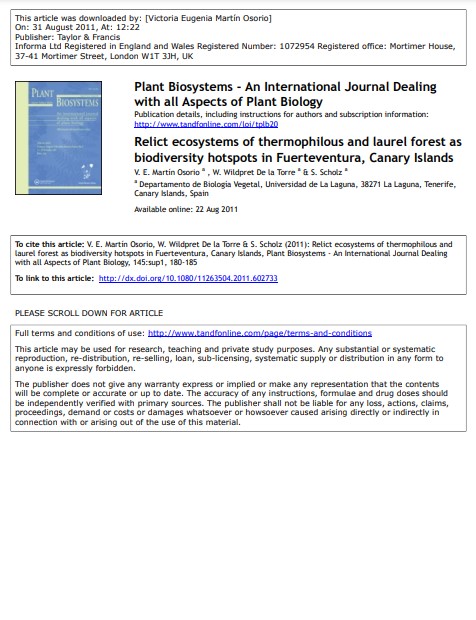Relict ecosystems of thermophilous and laurel forest as biodiversity hotspots in Fuerteventura, Canary Islands
Bosque Modelo:
Nova Forest Alliance
Temática:
Conservación
Tipo de documento:
Artículo científico
Resumen
A study of relict communities of thermophilous and laurel forest vegetation on Fuerteventura is presented. We describe four syntaxa, an alliance Astericion sericii all. nova and two associations, Bupleuro handiense-Maytenetum canariensis ass. nova and Carlino salicifoliae-Echietum famarae ass. nova (Oleo cerasiformis-Rhamnetea crenulatae). An association Echio handienseVisneetum mocanerae ass. nova belongs to Pruno hixae-Lauretea novocanariensi. These communities are small remnants of two well-represented types of vegetation in the central and western Canaries. At present, they are confined to very small localities on this island. This scarcity is partially related to bioclimatic factors but is fundamentally due to intense use of the natural resources by humans since the initial settlement of the islands, around 2100–2200 years before present. A chorological study of plant associations belonging to the above alliances, based on the Geobotanic Information System (GBOTIS), as well as a summarised phytosociological table of these associations is presented. A syntaxonomic scheme, a study of the vegetation structure is included.
Información Bibliográfica
Autor:
Martin Osorio, V. E.; Wildpret De la Torre, W.; Scholz, S.
Revista:
PLANT BIOSYSTEMS
Año:
2011
N°:
-
País :
Canadá
Páginas:
180 - 185
Volumen:
145
Idioma:
Ingles
Palabras claves
Endangered endemics, geographic information system (GIS), GBOTIS, Mediterranean biogeographical region, Oleo-Rhamnetea crenulatae, Pruno-Lauretea novocanariensis, relict ecosystems





